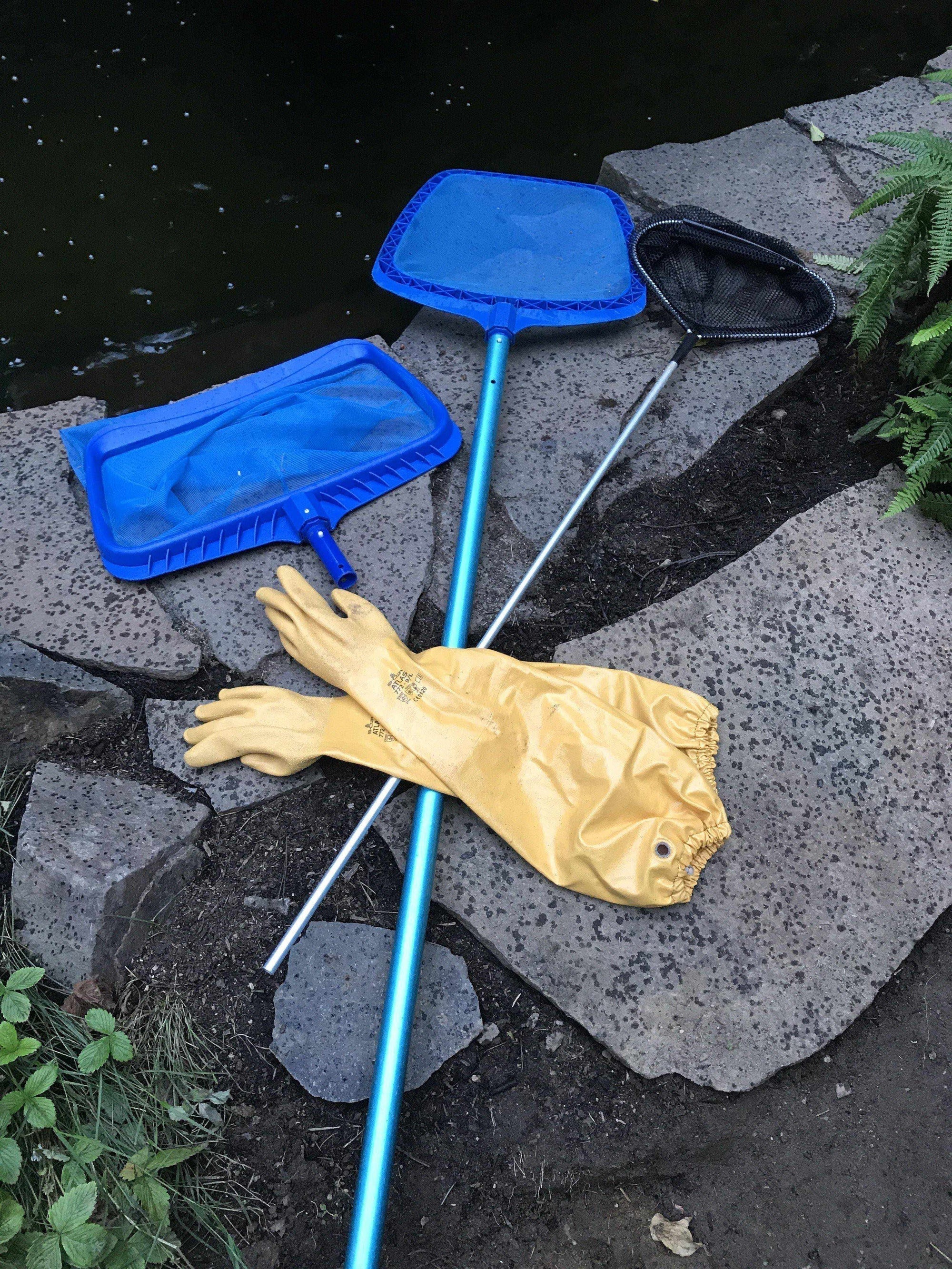The following is a list of specialized tools which are needed or helpful in and around your pond. These include hand and power tools, plumbing and measuring devices and even body protection.
Hand Tools: Most pool owners have an adjusting telescoping pole that can snap on skimmer, nets or aquatic rakes, to their ends. This is a must-have for ponders with large, wide or deep ponds to fish out wayward items, debris or fish from your system. The heads can be removed and used by hand as well. I fashioned a hook with a blunt end which is great for removing potted plants from stands in my pond (I attached a copper wire to the pots so I can hook them and lift out) or retrieving lost objects from the water.
Plumbing Tools: There are a number of handy plumbing tools that you should have on-hand. First, get a pair of strap wrenches (a large and small). These are excellent replacements for pipe wrenches for use with plastic pipe. They have a handle and rubber strap – great for tightening or loosening slip unions or removing unglued pipes from a fitting. Another is a ball valve wrench. There are some that are made to slip over the tee-wing handle, or you can make your own by cutting two grooves on a scrap piece of pipe that fits over the center handle just big enough for the wings to fit (similar to a faucet wrench). Glue a tee on the other end with scrap pipe handles. Just be careful not to apply too much pressure on the shutoff. Although plastic pipes can be cut by hand using a myriad of saw types, for large projects, it’s advisable to have a powered miter or chop saw with a fine-toothed blade. Use sandpaper or a file to remove detritus.
Pond Vacuum: For anything larger than a shallow, kiddy pool size, it’s essential. Wet/dry vacuums do not have the power. Checking pond-specific options, you will see there are numerous choices out there and they are all pricy. Look for vacuums that suck and discharge simultaneously. Why? It will take only a couple of minutes to fill the tank. This means you will have to stop every few minutes to empty the water and sludge out. Instead, you can clean for a meaningful amount of time. Two-motor models have a powered discharge ejecting water from the tank. Discharge vacuumed water to your waste system (not the pond). For features with rocks on the bottom, ensure to pick up a gravel-head attachment which is a large inverted funnel. Stick the head into the gravel and agitate. This will suck sludge and muck from between the rocks.
Pond Clothes: No, not fashion-wear, but rather waterproof protection for cleaning out or working in your pond water. Pond gloves are heavy-duty gloves that have long sleeves attached rising up to your bicep or armpit with elastic. There are a myriad of waterproof boots (shins or knees), pants (waist), or hip-waders (just below your arms) which, depending on your size – keep you dry in 4’ of water. Note that hip waders have a shoe, waist and body size (the material has little give), so ensure you measure yourself properly. After that, you would have to switch to wet suits for full body protection. If the water is cold (below 50° - 60°) and cold air temps, dry suits, gloves, and head protection is a must as cold water can be life-threatening. In extreme pond sizes, snorkeling, snuba and scuba gear may be appropriate (with proper training of course).
Measuring Devices: Translucent pales and buckets with quart or gallon marks are a must-have and you will appreciate having them. A staff-head gauge tailored to your pond will aid you in the pond’s current depth, knowing volume or water added or removed, and how long it will take to fill or drain your feature. A high-quality in-line water meter attached to your fill line is invaluable (usually brass with a cover and look much like your home’s water meter). A good water timer to regulate fills is also handy to have. A pressure test gauge is an inexpensive way to measure the PSI on your fill line. Of course, water test kits are a must.
Previous Article: 21: Pond Water - Management
Next Article: 23: Pond Gear - Safety Devices


2 comments
Jeff Richardson
Ahh yes, I will be getting more in-depth with fish, hospital tanks, etc. Wow, never thought about a microscope. Some fishy disorders can be seen for diagnosis! You would think by now there would be a solution that would turn a color to let you know! LOL
Anonymous
Good article. I chuckled a little bit on the wetsuit part, but you are totally right. I’m happy to own one, especially during spring clean outs. :-)
Couple other suggestions for pond tools I find useful, are a microscope for parasite identification and a viewing bowl for koi inspection.